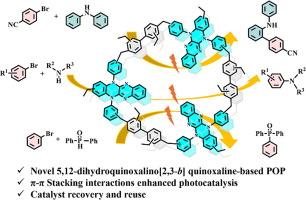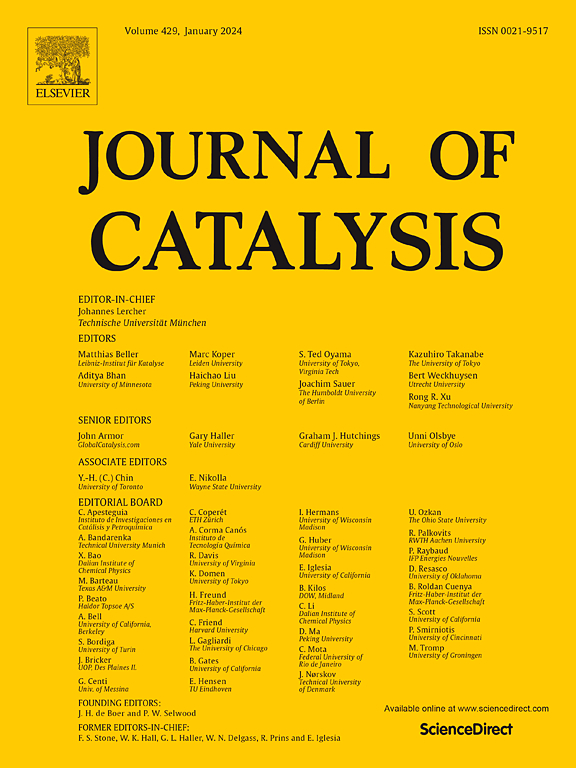5,12-Dihydroquinoxalino[2,3-b] quinoxaline-based porous organic polymer as photocatalyst for visible-light-driven cross-coupling reactions
IF 6.5
1区 化学
Q2 CHEMISTRY, PHYSICAL
引用次数: 0
Abstract
Porous organic polymers (POPs) have emerged as a novel porous photocatalyst that are prepared by the polymerization of various organic building blocks with different geometries and topologies. Herein, a novel 5,12-dihydroquinoxalino[2,3-b] quinoxaline-based POP was prepared by crosslinking with 5,12-diphenyl-5,12-dihydroquinoxalino [2,3-b] quinoxaline and 4,4′-bis(chloromethyl)-1,1′-biphenyl through FeCl3-catalyzed Friedel–Crafts alkylation reaction. With the broad absorption in the visible light region, the 5,12-dihydroquinoxalino[2,3-b] quinoxaline-based POP efficiently catalyzed diverse photocatalytic C − X (X =N, P, C) cross-coupling reactions. The 5,12-dihydroquinoxalino[2,3-b] quinoxaline-based POP catalyst tolerated a diverse range of coupling partners to deliver the products in up to 90 % yields and could be readily recovered over five times by simple filtration without appreciable loss of catalytic activity, providing a promising platform for heterogeneous photocatalytic organic transformations. The successful application of this polymerization-enhanced photocatalysis strategy should guide an approach to the rational design of POP-type heterogeneous photocatalysts to address the dilemma of homogeneous photocatalysts in sustainability, stability, and recyclability.

基于 5,12-二氢喹喔啉并[2,3-b] 喹喔啉的多孔有机聚合物作为光催化剂用于可见光驱动的交叉偶联反应
多孔有机聚合物(POPs)是一种新型的多孔光催化剂,它是由具有不同几何形状和拓扑结构的各种有机构建块聚合而成的。本文以5,12-二苯基-5,12-二氢喹啉[2,3-b]喹啉和4,4′-双(氯甲基)-1,1′-联苯为原料,通过fecl3催化的Friedel-Crafts烷基化反应,交联制备了新型的5,12-二氢喹啉[2,3-b]基POP。基于5,12-二氢喹啉[2,3-b]喹啉的POP在可见光区有较宽的吸收,能有效催化多种光催化C − X (X =N, P, C)交叉偶联反应。基于5,12-二氢喹啉[2,3-b]喹啉的POP催化剂耐受多种偶联伙伴,以高达90% %的收率提供产品,并且通过简单的过滤可以很容易地回收超过5次而不会明显损失催化活性,为非均相光催化有机转化提供了一个有希望的平台。这种聚合增强光催化策略的成功应用将为合理设计pop型多相光催化剂提供指导,以解决均相光催化剂在可持续性、稳定性和可回收性方面的难题。
本文章由计算机程序翻译,如有差异,请以英文原文为准。
求助全文
约1分钟内获得全文
求助全文
来源期刊

Journal of Catalysis
工程技术-工程:化工
CiteScore
12.30
自引率
5.50%
发文量
447
审稿时长
31 days
期刊介绍:
The Journal of Catalysis publishes scholarly articles on both heterogeneous and homogeneous catalysis, covering a wide range of chemical transformations. These include various types of catalysis, such as those mediated by photons, plasmons, and electrons. The focus of the studies is to understand the relationship between catalytic function and the underlying chemical properties of surfaces and metal complexes.
The articles in the journal offer innovative concepts and explore the synthesis and kinetics of inorganic solids and homogeneous complexes. Furthermore, they discuss spectroscopic techniques for characterizing catalysts, investigate the interaction of probes and reacting species with catalysts, and employ theoretical methods.
The research presented in the journal should have direct relevance to the field of catalytic processes, addressing either fundamental aspects or applications of catalysis.
 求助内容:
求助内容: 应助结果提醒方式:
应助结果提醒方式:


